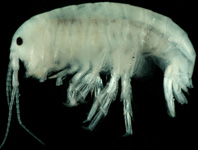Abstract
The genus Hyalella is endemic to the North and South America. There are currently 14 species described in North America and the Caribbean. For a long time, it had been assumed that different populations of these animals represented a single species, Hyalella azteca (Saussure, 1858). However, molecular analyses have demonstrated H. azteca sensu lato to be a complex of multiple species, so some species that occur in the United States have been mistakenly identified. Our aim in this paper was to describe a new species of Hyalella, found in Oklahoma, USA. The new species can be differentiated from the others, mainly because it presents serrated setae in the maxilla 2, because it does not have flanges on the surface of the body, presents the palm of the gnathopod 2 of the same size as the distal-posterior margin of the propodus, by shape and number of setae on the uropod 3 and telson. The description of this new species of Hyalella increases to 15 the number of species of the genus for the USA. It is important to understand the diversity of Hyalella with consideration of their possible role as bioindicators of environmental quality, and further consideration of their conservation status, and especially for species known from a single spring.
References
Baldinger, A.J. (2004) A new species of Hyalella (Crustacea: Amphipoda: Hyalellidae) from Ash Springs, Lincoln County, Nevada, USA, with a key to the species of the genus in North America and the Caribbean region. Journal of Natural History, 38, 1087–1096.
https://doi.org/10.1080/0022293031000075367
Baldinger, A.J., Shepard, W.D. & Threloff, D.L. (2000) Two new species of Hyalella (Crustacea: Amphipoda: Hyalellidae) from Death Valley National Park, California, USA. Proceedings-Biological Society of Washington, 113 (2), 443–457.
Bousfield, E.L. (1996) A contribution to the reclassification of Neotropical freshwater hyalellid amphipods (Crustacea: Gammaridea, Talitroidea). Bolletino del Museo Civico di Storia Naturale de Verona, 20, 175–224.
Bueno, A.A.P., Araujo, P.B., Cardoso, G.M., Gomes, K.M. & Bond-Buckup, G. (2013) Two new species of Hyalella (Amphipoda, Dogielinotidae) from Brazil. Crustaceana, 86 (7–8), 802–819.
https://doi.org/10.1163/15685403-00003205
Cardoso, G.M., Araujo, P.B., Bueno, A.A.P. & Ferreira, R.L. (2014) Two new subterranean species of Hyalella Smith, 1874 (Crustacea: Amphipoda: Hyalellidae) from Brazil. Zootaxa, 3814 (3), 353–368.
https://doi.org/10.11646/zootaxa.3814.3.3
Cole, G. & Watkins, R.L. (1977) Hyalella montezuma, a new species (Crustacea: Amphipoda) from Montezuma Well, Arizona. Hydrobiologia, 52 (2–3), 175–184.
https://doi.org/10.1007/BF00036441
Drumm, D.T. & Knight-Gray, J. (2019) A new species of the Hyalella `azteca` complex (Crustacea: Amphipoda: Hyalellidae). Zootaxa, 4545 (1), 093–104.
https://doi.org/10.11646/zootaxa.4545.1.5
Gonzalez, E.R. & Watling, L. (2002) Redescription of Hyalella azteca from its type locality, Vera Cruz, Mexico (Amphipoda: Hyalellidae). Journal of Crustacean Biology, 22 (1), 173–183.
https://doi.org/10.1163/20021975-99990220
Grosso, L. & Peralta, M. (1999) Anfípodos de agua dulce sudamericanos. Revisión del género Hyalella Smith. Acta Zoologica Lilloana, 45, 79–98.
Marrón-Becerra, A., Hermoso-Salazar, M. & Solís-Weiss, V. (2014) Hyalella cenotensis, a new species of Hyalellidae (Crustacea: Amphipoda) from the Yucatán Peninsula, Mexico. Zootaxa, 3811 (2), 262–270.
https://doi.org/10.11646/zootaxa.3811.2.7
Marrón-Becerra, A., Hermoso-Salazar, M. & Solís-Weiss, V. (2018) Hyalella maya, a new Hyalellidae species (Crustacea, Amphipoda) from a cenote the in Yucatán Peninsula, Mexico. Journal of Cave and Karst Studies, 80 (2), 1–11.
https://doi.org/10.4311/2017LSC0115
Mateus, A. & Mateus, E. (1987) Etude d’une collection d’amphipodes spécialement du sud-ouest asiatique–du Muséum d’Histoire Naturelle de Vienne (Autriche). Annalen des Naturhistorischen Museums in Wien. Serie B für Botanik und Zoologie, 91 (B), 273–331.
Rodriques, S.G., Bueno, A.A.P. & Ferreira, R.L. (2014) A new troglobiotic species of Hyalella (Crustacea, Amphipoda, Hyalellidae) with a taxonomic key for the Brazilian species. Zootaxa, 3815 (2), 200–214.
https://doi.org/10.11646/zootaxa.3815.2.2
Saussure, H. (1858) Memoire sur divers crustaces nouveaux des Antilles et du Mexique. Meìmoires de la Socieìteì de Physique et d’Histoire Naturelle de GeneÌve, 14, 417–496.
Smith, S. (1974) The Crustacea of the freshwaters of the United States. A Synopsis of the Higher Freshwater Crustacea of the Northern United States. Appendix F. Natural History. Report of the Commissioner for 1872 and 1873. United States Commission of Fish and Fisheries, 2, 637–661.
Smith, S. (1875) Report on the amphipod crustaceans of Colorado. Annual Report of the United States Geological and Geographic Survey of the Territories for 1873, 1875, 608–611.
Soucek, D.J, Lazo-Wasem, E.A., Taylor, C.A. & Major, K.M. (2015) Description of two new species of Hyalella (Amphipoda: Hyalellidae) from Eastern North America with a revised key to North American members of the genus. Journal of Crustacean Biology, 35 (6), 814–829.
https://doi.org/10.1163/1937240X-00002373
Stevenson, M.M. & Peden, A.E. (1973) Description and ecology of Hyalella texana n. sp. (Crustacea: Amphipoda) from the Edwards Plateau of Texas. American Midland Naturalist, 89 (2), 426–436.
https://doi.org/10.2307/2424045
Wellborn, G.A. & Cothran, R.D. (2004) Phenotypic similarity and differentiation among sympatric cryptic species in a freshwater amphipod species complex. Freshwater Biology, 49 (1), 1–13.
https://doi.org/10.1046/j.1365-2426.2003.01160.x
Wellborn, G.A., Cothran, R.D. & Bartholf, S. (2005) Life history and allozyme diversification in regional ecomorphs of the Hyalella azteca (Crustacea: Amphipoda) species complex. Biological Journal of the Linnean Society, 84 (1), 161–175.
https://doi.org/10.1111/j.1095-8312.2005.00422.x
Wellborn, G.A. & Broughton, R.E. (2008) Diversification on an ecologically constrained adaptative landscape. Molecular Ecology, 17, 2927–2936.
https://doi.org/10.1111/j.1365-294X.2008.03805.x
Witt, J.D.S., Blinn, D.W. & Herbet, P.D.N. (2003) The recent evolutionary origin of the phenotypically novel amphipod Hyalella montezuma offers an ecological explanation for morphological stasis in a closely allied species complex. Molecular Ecology, 12, 405–413.
https://doi.org/10.1046/j.1365-294X.2003.01728.x
Witt, J.D.S., Threloff, D.L. & Hebert, P.D.N. (2006) DNA barcoding reveals extraordinary cryptic diversity in an amphipod genus: implications for desert spring conservation. Molecular Ecology, 15 (1), 3073–3082.
https://doi.org/10.1111/j.1365-294X.2006.02999.x
Zimmer, A., Araujo, P.B. & Bond-Buckup, G. (2009) Diversity and arrangement of the cuticular structures of Hyalella (Crustacea: Amphipoda: Dogielinotidae) and their use in taxonomy. Zoology, 26 (1), 127–142.

